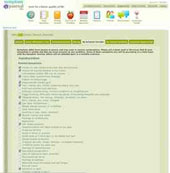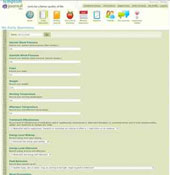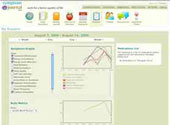Health Tools That Help Reduce Autism Symptoms
You want to give your child the moon and the stars…
You will move any mountain and try most any therapy to improve your child’s live with Autism
You see gifts in the smallest gestures and gains
You look at your life and your child’s differently since their autism diagnosis
You know your child has so much to teach you because they look at the world from a different perspective
Your child’s quality of life is about symptom reduction, reduce their symptoms and their life improves
Your Commitment + Our Health Tools
Helping You Reduce Your Child's Symptoms
Help reduce your child’s Autism symptoms as a Symptom Journal member:
- Your Symptom Journal membership gives you a plan. You have a history of your child’s Autism symptoms and health outcomes saving months or years discovering how to reduce your child’s symptoms.
- You have a feedback monitor or GPS.Help for navigating the sometimes-intense data driven methods for helping your child reduce their Autism symptoms by tracking therapies, bio-medical interventions, diets and educational interventions all in one place.
- You have a system for keeping your child’s body operating at it’s best with Autism. You have an integrated system for tracking what your child eats; their sleeps patterns, and exercise—all key components in keeping their body operating at it’s best.
- You know how to reduce your child’s symptoms. You have reports showing how their health condition, treatments, and educational plans are working or not working enabling you and your doctor or educational team to make changes that can reduce your child’s Autism symptoms.
- You know how to help your child create their best life. You see in your child’s reports exactly how, what, why, and when their Autism symptoms increase or decrease—a roadmap to know what to change to reduce your child’s symptoms and create their best life.
- You can take back your power and take control of your child’s health. In less than 5 minutes a day, our patent-pending technology shows you how your child’s lifestyle choices, nutrition, and treatment affect their Autism symptoms. Have the reports you need for IEP’s that helps your child get their best education.
Take the Challenge-14 Days Giving You Tools & Possibilities for Your Child
Give us 14 days and we will show you how to reduce your child’s symptoms as a Symptom Journal member. You have nothing to lose and everything to gain, click on the JOIN button and become a member today!
Track Your Symptoms Track your symptoms and learn how to reduce your symptoms and bring your illnesses under control. In 2-3 minutes a day you can answer daily questions that can show you how to create a healthier life. Track your symptoms and learn how to reduce your symptoms and bring your illnesses under control. In 2-3 minutes a day you can answer daily questions that can show you how to create a healthier life. |
Find Answers Get answers through reports that show you exactly how, what, why, and when your symptoms increase or decrease, helping you achieve amazing results and a healthier life. Get answers through reports that show you exactly how, what, why, and when your symptoms increase or decrease, helping you achieve amazing results and a healthier life. |
Live Well! Live well and know what choices to change based on the results you see in your reports. Your reports show you how to create a healthier life and with your doctor's help you can modify your treatment plan and live your best life. Live well and know what choices to change based on the results you see in your reports. Your reports show you how to create a healthier life and with your doctor's help you can modify your treatment plan and live your best life. |
Track Your Symptoms + Find Answers = Live Well!
Help Your Child Live Their Best Life with Autism
Discover the power of symptom tracking:
- Discover in real time if your child's autism symptoms are increasing or decreasing because of their nutrition, medications, bio-medical or educational interventions, and therapies, and how these choices affect your child's health outcomes.
- Life-changing results can be theirs through symptom tracking; eliminate wasted months and potentially years of not having accurate answers about what is working or not in your child's treatment plan.
- Feel confident with reports that you can share with your child's doctor or educatonal team when discussing their health, giving you facts to back up how your child is feeling and how your child's treatment plan is working or not working.
- The goal of symptom tracking is symptom reduction allowing you to manage your child's health and create their best quality of life.
Most of us have systems for managing our finances, weight, time, and exercise. Managing your child's health is no different. You can't manage what you don't track. We are patients like you, who took action, created web-based health tools, found solutions to difficult questions, and wanted to share our discoveries to help you create your child's best quality of life with autism. Join our community as a Symptom Journal member and help your child live their best life.
You Can't Manage What You Don't Track
What is Autism?
Autism Spectrum Disorders (ASDs), also known as Pervasive Developmental Disorders (PDDs), cause severe and pervasive impairment in thinking, feeling, language, and the ability to relate to others. These disorders are usually first diagnosed in early childhood and range from a severe form, called autistic disorder, through pervasive development disorder not otherwise specified (PDD-NOS), to a much milder form, Asperger syndrome. The incidence of ASD is estimated at probably 1 in every 120 births, with boys being affected about 4 times more often than girls. Generally, the earlier the disorder is diagnosed, the sooner the child can be helped through treatment interventions. Learn more about autism for your child as a member of the Symptom Journal.
Causes of Autism
There is no known cause for ASD. Scientists believe that both genetics and environment play a part. Studies on families with children with ASD have been helpful in understanding how genes play a role. Current research points to brain abnormalities as the cause of AS. Using advanced brain imaging techniques, scientists have found structural and functional differences in specific regions of the brains of neuro-typical versus ASD children.
There are many different theories about causes of Autism Spectrum Disorder. Many studies are being conducted about differences in brain activity with ASD children. Scientists have always known that there had to be a genetic component to ASD because of their tendency to run in families. A specific gene for autism, however, has not yet been identified. Inside the members area of the Symptom Journal, we discuss in detail the different theories and possible risk factors that are associated with Autism Spectrum Disorder.
Symptoms of Autism
Children with Autism display impairments in social interaction, impairments in communication, and display many different forms of restricted and repetitive behavior. From the start, typical developing infants are social beings. Early in life, they gaze at people, turn toward voices, grasp a finger, and even smile. In contrast, most children with ASD seem to have tremendous difficulty learning to engage in the give-and-take of everyday human interaction. In the Members area, we discuss at length the different challenges with social interaction that Autistic children can tend to have.
By age 3, most children have passed predictable milestones on the path to learning language. One of the earliest is babbling. By the first birthday, a typical toddler says words, turns when he hears his name, and points when he wants a toy. Some children diagnosed with ASD remain nonverbal throughout their lives. Some infants who later show signs of ASD coo and babble during the first few months of life, but then soon stop. Others may be delayed, developing language as late as age 5 to 9.
Children with ASD often times display restricted and repetitive behaviors, which may include: compulsive behavior, restricted behavior, ritualistic behavior and a need for sameness. An extensive list of symptoms for autism is presented in your child’s Symptom Checklist. Through their Daily Questions, you can monitor how their autism symptoms, treatment, and lifestyle are affecting their overall health.
Diagnosis, Treatment & Self-Care with Autism
Understanding the process your doctor may use in diagnosing your child with autism helps you ask questions and better understanding your child’s autism diagnosis and treatment process. In the members area, there is a full description of the autism diagnosis process and possible tests that their doctor may order to determine whether your child demonstrates symptoms that are known to be associated with ASD. We discuss the conventional treatment options along with alternative and complementary treatments, including biomedical interventions that other parents of children with Autism Spectrum Disorder have found helpful for their children. Our autism Self-Care section for members explains how simple lifestyle choices can help improve your child’s outcomes and quality of life.
As a member of the Symptom Journal, you will be able to see how your child’s treatment, lifestyle choices, and nutrition correlate with how their symptoms spike or lessen through our Reports area, allowing you to make timely changes with your healthcare and educational teams that will ultimately save you frustration, time and energy. The information you receive from your child's reports will help you make changes that help your child live their best life with autism.
Nutrition & Support with Autism
In the Nutrition section for members, we cover some of the most popular diets that parents of children with autism have used to positively affect their child’s quality of life and outcomes with autism. We also provide an Inspiration Toolkit for our members, giving parents tools, support, and motivational techniques for staying inspired with their child’s health journey. We understand the day-to-day challenges with autism and want to support you in creating the best quality of life for your child and family.
Still not convinced that Symptom Journal can make a significant and positive change in your child's health, then Read Tamara's Story > and see how symptom tracking changed her life.

and learn how to reduce your symptoms and bring your illnesses under control. In less than 5 minutes a day learn how to create a healthier life.

through reports that show how, what, why, and when your symptoms increase or decrease, helping you achieve amazing results and a healthier life.

and know what choices to change based on results you see in your reports, showing you and your doctor how to reduce your symptoms so you can live your best life.











